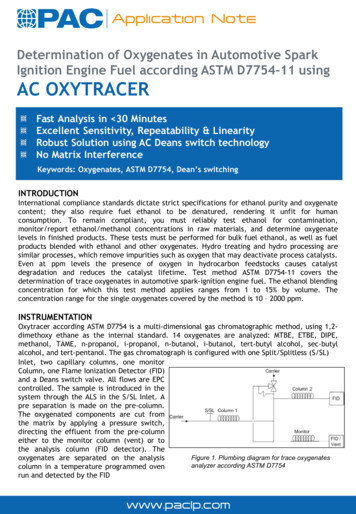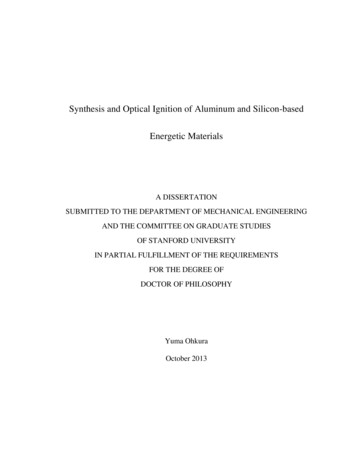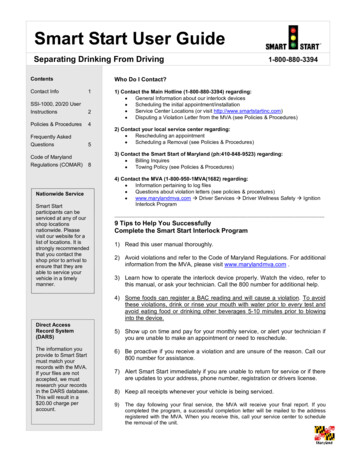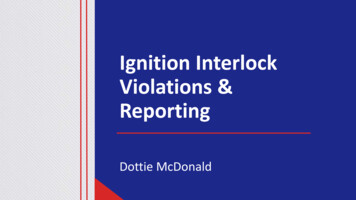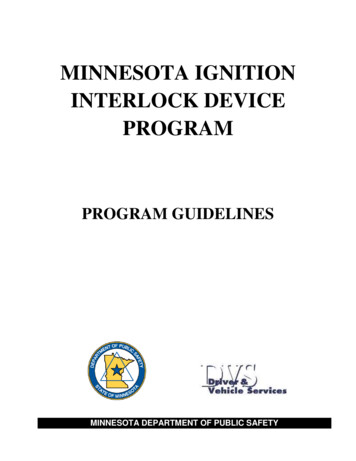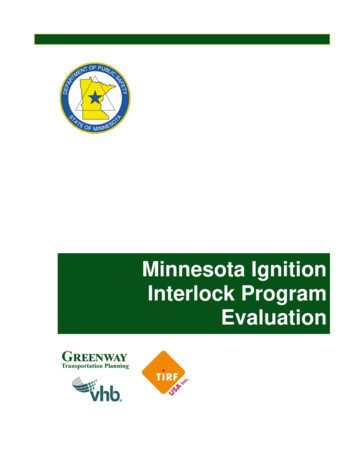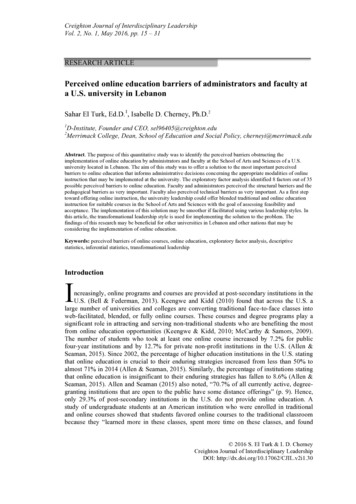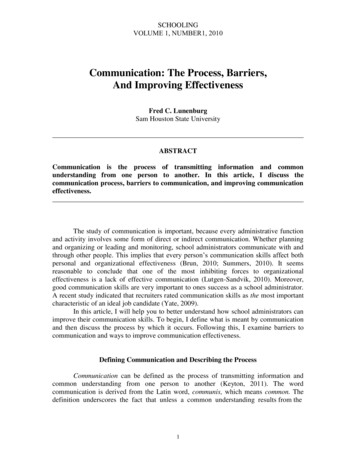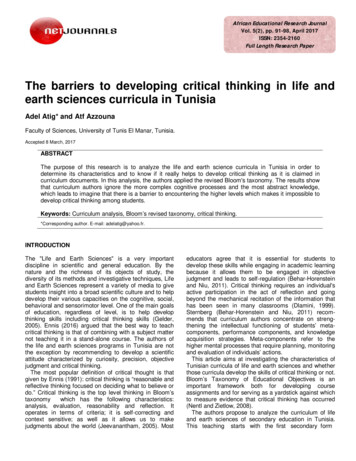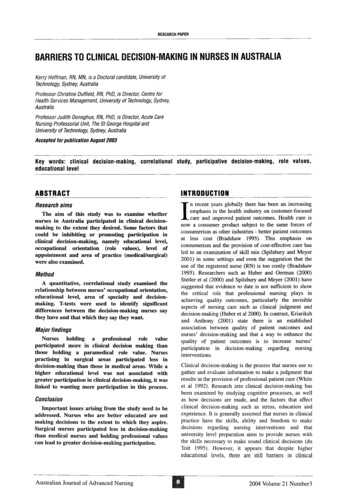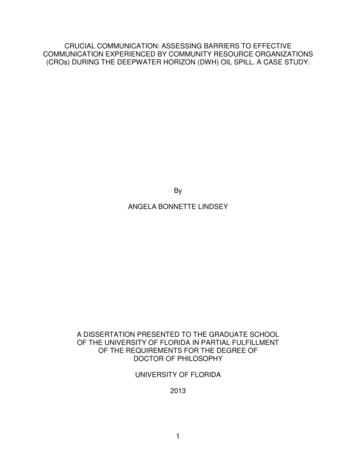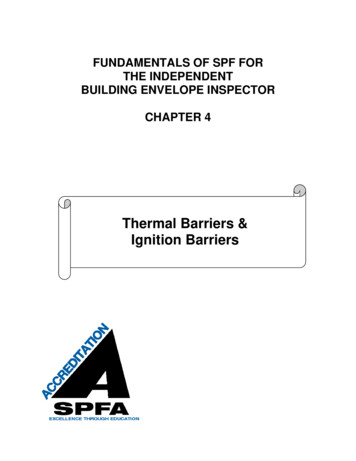
Transcription
FUNDAMENTALS OF SPF FORTHE INDEPENDENTBUILDING ENVELOPE INSPECTORCHAPTER 4Thermal Barriers &Ignition Barriers
FUNDAMENTALS OF SPF FOR BE INSPECTORCONTENTSCHAPTER 4PAGETHERMAL BARRIERS FOR THE SPRAY POLYURETHANE FOAM INDUSTRY . 3WHAT IS A THERMAL BARRIER? . 3WHERE IS A THERMAL BARRIER REQUIRED? . 4WHY DO CODES REQUIRE THERMAL BARRIERS? . 4SELECTION OF THERMAL BARRIERS . 5CELLULOSE THERMAL BARRIERS . 7SPRAY APPLIED CEMENTITIOUS MATERIALS . 7GYPSUM WALLBOARD . 7IGNITION BARRIERS FOR THE SPRAY POLYURETHANE FOAM INDUSTRY . 8WHAT IS AN IGNITION BARRIER? . 8WHERE IS AN IGNITION BARRIER PERMITTED? . 8SELECTION OF IGNITION BARRIERS. 10SUMMARY . 11SELF-QUIZ . 12These course materials have been prepared and reviewed by the SPFA Accreditation Committee andaccepted for use in connection with the SPFA Spray Polyurethane Foam Accreditation Program on the basisof established industry criteria. The course materials are offered for educational and training purposes onlyand without any representation or warranty, express or implied, by SPFA as to the quality of performance ofthe products used or services rendered by an individual or company completing the training program. SPFAand its members specifically disclaim any and all liability for any losses, damages, injuries or damages topersons or property arising out of or resulting from the use or reliance upon these course materials by anyparty. SPFA neither endorses or guarantees the proprietary products or services of any particular companyor individual that may be mentioned or featured in these materials.Spray Polyurethane Foam Alliance4400 Fair Lakes Court, Suite 105 Fairfax, VA 22033800-523-6154www.sprayfoam.org
FUNDAMENTALS OF SPF FOR BE INSPECTORCHAPTER 4THERMAL BARRIERS FOR THE SPRAY POLYURETHANE FOAM INDUSTRYWHAT IS A THERMAL BARRIER?A thermal barrier is a material, applied between foam plastics (including spraypolyurethane foam) and interior spaces designed to delay the temperature rise of thefoam during a fire situation and to delay or prevent the foam's involvement in a fire.The International Building Code (IBC) and the International Residential Code (IRC)define an approved thermal barrier as one which is equal in fire resistance to 12.7 mm(1/2 inch) gypsum wallboard. In essence, the model building codes define ½-inchgypsum wallboard as a prescriptive thermal barrier; approved equivalents (nonprescriptive thermal barriers) must perform as well as or better than ½-inch gypsumwallboard in fire testing as described below.Non-prescriptive thermal barriers (termed “equivalent thermal barriers”) must undergo atemperature transmission fire test wherein the temperature rise of the underlyingpolyurethane foam is limited to not more than 121ºC (250ºF) after 15 minutes of fireexposure complying with the standard time temperature curve of ASTM E 119 (TestMethods for Fire Tests of Building Construction Materials). Additionally, equivalentthermal barriers must undergo a fire integrity test to establish that they will sufficientlyremain in place during a fire scenario by passing a large-scale, 15-minute fire test.Equivalent thermal barriers meeting this criterion are termed a “15-minute thermalbarrier” or classified as having an “index of 15.”In effect, equivalent thermal barriers (i.e., other than theprescriptive ½-inch thick gypsum wallboard) mustundergo two fire tests:(1) A temperature transmission test (such as amodified ASTM E 119, the actual thermal barriertestapparatus being smaller than the typicallarge-scale wall or roof/ceiling test assemblies); and(2) A fire integrity test (a large-scale fire test such asNFPA 286 [with a specific acceptance criteriadefined within the IBC or IRC], UL 1040, UL 1715 orFM 4880).NFPA 275 (Standard Method of Fire Tests for theEvaluation of Thermal Barriers Used over Foam PlasticInsulation) is an approved test standard per AC 377 forequivalent thermal barriers that incorporates both atemperature transmission fire test and a fire integritytest. Future editions of model building codes will likelyinclude NFPA 275 as an acceptable test method.Since alternative assemblies mustundergo the same large-scale firetest(s) as equivalent thermal barriers,many manufacturers have foregonethe temperature transmission testing(e.g., ASTM E 119). Such materials arenot classified as equivalent thermalbarriers but may be used as analternative assembly provided it hasbeen approved by the code authorityhaving jurisdiction.AC 377 is the Acceptance Criteria forSpray-Applied Foam Plastic Insulationpublished by International CodeCouncil Evaluation Service (ICC-ES) forthe purpose of preparing evaluationreports. Copies are available at theICC-ES website www.ICC-ES.org.Under specific conditions, the temperature transmission test can be waived if approved SPFA3
FUNDAMENTALS OF SPF FOR BE INSPECTORCHAPTER 4by building code authorities on the basis of large-scale fire testing representing actualend uses. Many materials which are not “15-minute thermal barriers” per ASTM E 119or NFPA 275, or classified as equivalent thermal barriers have earned various buildingcode acceptances as an alternate to the use of thermal barriers over spraypolyurethane foam (SPF) based on large-scale fire testing. The assembly, consisting ofeither the exposed foam plastic or the foam plastic with a fire-retardant coating is testedusing one of the following procedures: NFPA 286 Standard Methods of Fire Tests for Evaluating Contribution of Walland Ceiling Interior Finish to Room Fire Growth (Note: NFPA 286 does notinclude pass/fail criteria within it; the criteria is specifically defined within the IBCand IRC.) UL 1715 Fire Test of Interior Finish Material UL 1040 Insulated Wall Construction FM 4880 Building Corner Fire TestWHERE IS A THERMAL BARRIER REQUIRED?All model building codes require that SPF, with some exceptions, be separated frominterior living spaces by an “approved thermal barrier.” Therefore, unless an exceptionapplies, all interior SPF applications are required to be covered with a thermal barrier,covered with an equivalent thermal barrier or be part of a tested alternative assembly.Exceptions to the thermal barrier requirement include:*Exterior applications as part of certain tested and classified roof assemblies;*Certain masonry or concrete constructions;*Certain attics and crawlspaces (see discussion under “Where Is An IgnitionBarrier Permitted?”);*Sill plates and headers (limited to certain SPFs in Type V construction); and*Others as provided by the model building codes.Review the specific code requirements on a case-by-case basis. For example, thebuilding codes do list some exceptions for cooler and freezer construction and youshould review the special building code requirements in these cases.WHY DO CODES REQUIRE THERMAL BARRIERS?Spray Polyurethane foam, like most other organic materials, is combustible. Spraypolyurethane foams are formulated with flame-retardants to decrease the flame spreadas measured by ASTM E-84 (Test for Surface Burning Characteristics for BuildingMaterials) and other tests. However, these flame-spread ratings are used solely tomeasure and describe properties of products in response to heat and flame undercontrolled laboratory conditions. The numerical flame spread ratings are not intended to SPFA4
FUNDAMENTALS OF SPF FOR BE INSPECTORCHAPTER 4reflect hazards presented by spray polyurethane foams or any other material underactual fire conditions in a real building.When exposed to fire sources, such as welding arcs, cutting torches, or red-hot metal,unprotected spray polyurethane foam may ignite resulting in a flash fire. The burningwill be brief, forming a layer of less flammable surface char. This initial burningproduces combustible gases and black smoke. In confined interiors, combustible gasescan accumulate and ignite resulting in flashover, a dangerous fire situation. Under theseconditions, additional foam or other combustibles can become involved in the fire givingoff additional combustible gases and feeding the fire. If the heat and gases are notdissipated and the temperature of the foam rises above approximately 379 C (700 F),the surface char will no longer be able to protect the foam and the foam will fuel the fireas it degrades under these extreme temperatures. Most sprayed polyurethane foamfires will involve other flammable materials, however, in a limited number of situations,when other flammable materials are not involved, sprayed polyurethane foam fires tendto be flash fires of relatively short duration.Codes require thermal barriers for interiors to reduce the risk of a flash fire and toextend the time at which the foam would reach its auto ignition temperature should afire originate from other sources.All interior SPF must be protected by a code approved thermal barrier and the thermalbarrier should be applied as soon as possible after polyurethane foam application. It isthe polyurethane foam contractor who is responsible for insuring that a thermal barrieris applied. No written or verbal contract or disclaimer of responsibility will protect thepolyurethane foam contractor from liability.(Note 1: These fire scenarios depend on the accumulation of combustible gases.Exterior applications of spray polyurethane foam, such as roof systems, wherecombustible gases can dissipate, are less likely to become involved in flash fires andare treated differently under the building codes.)SELECTION OF THERMAL BARRIERSConsider the following in the selection of a thermal barrier:1.2.3.4.5.Building code requirements.Adhesion to the spray polyurethane foam (when appropriate).Environment in which it is to be used.Aesthetic qualities.Ease of maintenance. SPFA5
FUNDAMENTALS OF SPF FOR BE INSPECTORCHAPTER 4Generally, SPF installers have three choices:1. Prescriptive thermal barrier: The IBC and IRCspecifically name ½-inch gypsum wallboard as an Equivalent thermal barriers and“approved” thermal barrier.alternative assemblies are tested as2. Equivalent thermal barriers: Materials equivalent to part of assemblies which include½-inch gypsum wallboard can be used as thermal specific formulations, materials,barriers provided they have been tested in thicknesses and densities. Unlessaccordance with the IBC or IRC to limit temperature otherwise approved by the coderise and remain in place for 15 minutes as authority having jurisdiction, thedescribed above in the “What is a Thermal Barrier” following rules apply:1. SPF may be installed atsection. Typical equivalent thermal barriers include:thicknesses and density equala. Spray-applied cementitious materialsto or less than tested;b. Spray-applied cellulose materials2. Protective materials must bec. Portland cement plasterinstalled at thicknesses equald. Other various proprietary materials.to or greater than tested;Evaluation reports can assist code officials in3.Formulations, materials anddetermining the code compliance of equivalentconstruction must conform tothermal barriers. Local building code officials arethat which was tested.permitted to allow the use of an equivalent thermalbarrier which has not been issued an evaluationreport provided that data satisfactory to the code official is submitted forapproval.3. Alternative assemblies: SPF may be covered with other materials (such asintumescent or other coating systems) or left exposed provided the assemblyhas been specifically approved on the basis of large-scale fire testingrepresenting the actual end-use configuration. Alternative assemblies may havea currently valid evaluation report. Local building code officials are permitted toallow the use of an alternate assembly which has not been issued an evaluationreport provided that data satisfactory to the code official is submitted forapproval. Generally accepted tests for alternative assemblies include: NFPA 286 Standard Methods of Fire Tests for Evaluating Contribution ofWall and Ceiling Interior Finish to Room Fire Growth (with specificacceptance criteria defined within the IBC or IRC) UL 1715 Fire Test of Interior Finish Material UL 1040 Insulated Wall Construction) FM 4880 Building Corner Fire Test)Alternative assemblies tested under AC 377, Appendix X are notappropriate alternative assemblies for meeting thermal barrierrequirements.Caution: Just because a material is advertised as a “thermal barrier” or an assembly isadvertised as not requiring a thermal barrier does not mean that it has been approvedby a code agency or a local code official. Ask for test data and code body approvals,listings, or other written indications of acceptability under the code to be sure that theproduct selected offers the fire protection that the code requires. SPFA6
FUNDAMENTALS OF SPF FOR BE INSPECTORCHAPTER 4CELLULOSE THERMAL BARRIERSCellulose thermal barriers are composed of a dry, wood pulp based fiber, a latexadhesive and borax/boric acid fire retardants. The dry fiber is packaged in 25 to 35 lb.bags that are placed into the hopper of the blowing machine. The fiber is broken up inthe hopper, metered through an air seal into the air stream created by the machine’sblower and carried through
modified ASTM E 119, the actual thermal barrier test apparatus being smaller than the typical large-scale wall or roof/ceiling test assemblies); and (2) A fire integrity test (a large-scale fire test such as NFPA 286 [with a specific acceptance criteria defined within the IBC or IRC], UL 1040, UL 1715 or FM 4880). NFPA 275 (Standard Method of Fire Tests for the Evaluation of Thermal Barriers .
